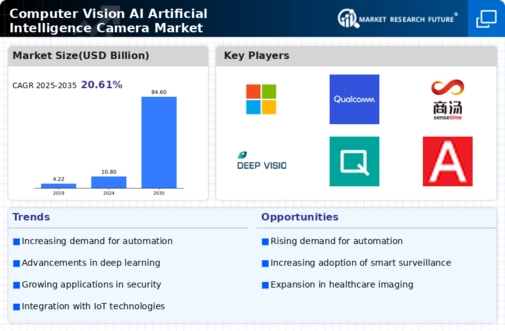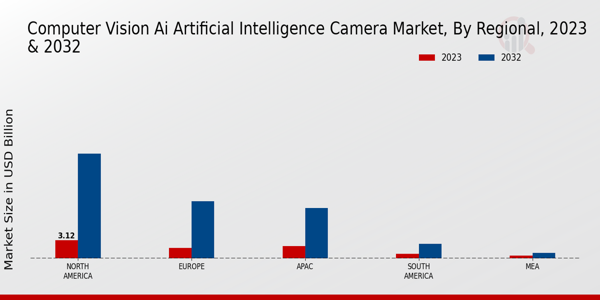Market Growth Projections
The Global Computer Vision AI Artificial Intelligence Camera Market Industry is projected to experience substantial growth over the coming years. The market is expected to reach 10.8 USD Billion in 2024, with a remarkable increase to 84.6 USD Billion by 2035. This growth trajectory indicates a compound annual growth rate of 20.61% from 2025 to 2035. Such projections highlight the increasing reliance on AI technology across various sectors, including security, retail, and manufacturing. The expanding applications of computer vision technology are likely to attract significant investments, further fueling market expansion.
Growing Adoption in Retail
The retail sector is increasingly adopting AI cameras to enhance customer experience and optimize operations, significantly impacting the Global Computer Vision AI Artificial Intelligence Camera Market Industry. Retailers utilize AI-driven cameras for inventory management, customer behavior analysis, and loss prevention. For example, smart shelves equipped with AI cameras can monitor stock levels and alert staff when restocking is needed. This trend not only improves operational efficiency but also enhances customer satisfaction by ensuring product availability. As retailers recognize the benefits of AI cameras, their adoption is expected to escalate, contributing to the overall market growth.
Increased Security Concerns
Growing security concerns across the globe are driving the demand for AI-powered surveillance solutions within the Global Computer Vision AI Artificial Intelligence Camera Market Industry. Governments and private organizations are investing heavily in security infrastructure to mitigate risks associated with crime and terrorism. AI cameras equipped with advanced analytics can monitor large areas and provide real-time alerts, enhancing public safety. For example, cities are deploying AI surveillance systems to monitor traffic and detect suspicious activities. This heightened focus on security is likely to sustain market growth, as organizations seek to implement robust surveillance measures to protect assets and individuals.
Integration with IoT Devices
The integration of AI cameras with Internet of Things (IoT) devices is emerging as a pivotal driver in the Global Computer Vision AI Artificial Intelligence Camera Market Industry. This synergy allows for seamless data exchange and enhanced functionality, enabling smarter surveillance systems. For instance, AI cameras can communicate with other IoT devices to optimize energy consumption and improve operational efficiency. As smart cities and connected environments gain traction, the demand for integrated solutions is expected to rise. This trend may lead to a compound annual growth rate of 20.61% from 2025 to 2035, reflecting the growing importance of interconnected technologies.
Rising Demand for Automation
The Global Computer Vision AI Artificial Intelligence Camera Market Industry is experiencing a surge in demand for automation across various sectors. Industries such as manufacturing, retail, and logistics are increasingly adopting AI-driven cameras to enhance operational efficiency and reduce human error. For instance, automated quality control systems utilize computer vision to identify defects in products, thereby improving overall quality. This trend is likely to contribute to the market's growth, with projections indicating a market size of 10.8 USD Billion in 2024. As businesses recognize the potential of automation, the adoption of AI cameras is expected to accelerate, driving the market forward.
Advancements in AI Technology
Technological advancements in artificial intelligence are significantly influencing the Global Computer Vision AI Artificial Intelligence Camera Market Industry. Innovations in deep learning algorithms and neural networks enhance the capabilities of AI cameras, enabling them to perform complex tasks such as facial recognition and object detection with high accuracy. For instance, AI cameras are now capable of analyzing real-time video feeds to identify security threats in public spaces. As these technologies continue to evolve, they are expected to attract more investments, further propelling the market. The anticipated growth trajectory suggests a market valuation of 84.6 USD Billion by 2035, reflecting the transformative impact of AI advancements.
















